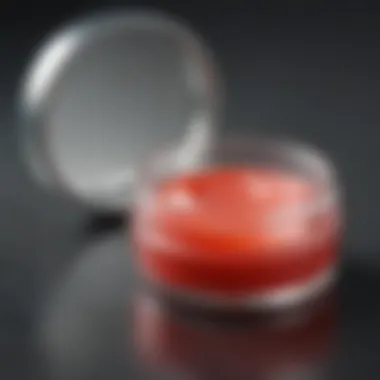Managing Rosacea: A Guide to Prescription Ointments


Intro
Rosacea is more than just a skin condition; it’s a daily struggle for many. Characterized by persistent redness, visible blood vessels, and often accompanied by bumps and pustules, rosacea can leave individuals feeling self-conscious and anxious about their appearance. Although it might seem like a cosmetic issue, the truth is that its ramifications can impact emotional well-being and self-esteem. Understanding how to treat and manage rosacea, particularly through prescription ointments, is crucial for individuals navigating this condition.
This article will cover various aspects related to prescription ointments for rosacea. From illuminating the causes and symptoms of rosacea to providing detailed information on how various treatments, including ointments, can alleviate discomfort, this guide aims to be a beacon of knowledge. Plus, practical skincare practices to complement these treatments will also be addressed. With an eye toward proper skincare, we aim to educate readers on how to effectively manage their skin and perhaps regain their confidence while doing so.
Understanding Rosacea
Rosacea is not just a skin condition; it can take a toll on one’s self-esteem and emotional well-being. This section sheds light on the nature of rosacea, aiming to demystify its characteristics and significance in the context of skincare. Understanding this condition is essential for anyone dealing with it, as it lays the foundation for exploring effective treatment options, particularly prescription ointments that may lead to symptom relief and an improved quality of life.
Definition and Symptoms
Rosacea is a chronic inflammatory skin condition that primarily affects the face. Those who contend with rosacea often experience persistent redness, particularly around the cheeks, nose, chin, and forehead. Alongside this redness, other common symptoms can include:
- Visible blood vessels that appear on the face
- Bumps and pus-filled lesions, resembling acne
- A burning sensation or a feeling of tightness in the skin
- Thickened skin in more severe cases, especially for individuals with phymatous rosacea
Individuals affected may find that the visible symptoms manifest unpredictably, often flaring up in reaction to various triggers. This unpredictability can be distressing, increasing the urgency to explore treatment options that suit their needs.
Types of Rosacea
The classification of rosacea into distinct types aids in understanding the broad spectrum of its presentation, and this article focuses on the four primary forms:
Erythematotelangiectatic Rosacea
Erythematotelangiectatic rosacea is characterized by facial redness, along with swollen, sensitive skin. This area often appears flushed, which can be mistaken for other conditions, like sunburn or allergy reactions. What sets this apart is the prevalence of telangiectasia, or visible blood vessels that can make the skin appear unevenly pigmented. The key characteristic here is the flushing that many experience when triggered by environmental factors or emotional stressors. Understanding this type is beneficial because it provides a clearer picture of how emotional and physical conditions can exacerbate one’s appearance, which is a common concern among those affected.
Papulopustular Rosacea
This variant combines persistent redness with acne-like breakouts. The key feature of papulopustular rosacea is the inflammatory papules and pustules that emerge, resembling common acne but without the presence of blackheads. This is significant because it can lead to confusion regarding the appropriate treatment. The unique aspect of this type is that it often brings a degree of discomfort, including itching and stinging. Those dealing with this subtype often feel caught between two worlds, managing the myriad of symptoms that connect to both rosacea and acne, making clarity in dealing with both conditions vital.
Phymatous Rosacea
Phymatous rosacea is less common but speaks volumes about the potential progression of untreated rosacea. In this type, skin thickening occurs, particularly on the nose, leading to a bulbous appearance. It often affects men more than women and tends to develop slowly over time. The most noteworthy characteristic of phymatous rosacea is how it can significantly alter one’s appearance, often leading to stigma and self-consciousness. The unique feature here lies in the thickness and texture of the skin that may not respond well to standard treatments, which in turn stresses the importance of early intervention and tailored treatment plans.
Ocular Rosacea
This type affects the eyes and can lead to symptoms like dryness, irritation, and swollen eyelids. A significant indicator of ocular rosacea is the presence of bloodshot eyes, which often goes unnoticed compared to facial symptoms. For many, this type can be particularly distressing, as it can inaccurately signal fatigue or disinterest. Understanding ocular rosacea’s contribution is critical, emphasizing the importance of consulting with both dermatologists and ophthalmologists for comprehensive care.
Common Triggers
Rosacea does not have a one-size-fits-all trigger, as it varies widely from person to person. Common triggers can be classified broadly into three categories:
Environmental Factors
Things like sun exposure, wind, temperature fluctuations, and humidity levels can exacerbate symptoms. For instance, cold, windy days can leave sensitive skin ever so irritated, making it look red or feel angry. Each environmental element has its role, revealing where proactive approaches can be beneficial.
Lifestyle Choices
Certain foods, beverages, and habits can set off rosacea flare-ups. Spicy foods, alcohol, and caffeine can energize that old flushing response, making it essential for individuals to keep a personal trigger log. Recognizing what contributes to their flare-ups can lead to better management strategies.
Genetic Predisposition
Research indicates that genetics play a significant role in rosacea. A family history of rosacea may increase one’s susceptibility. It’s a double-edged sword; there's little one can do about genetics, but understanding that such a predisposition exists can help in seeking treatment and avoiding triggers actively.


"Rosacea may change the face, but it doesn't have to change your spirit."
Understanding rosacea in depth lays a solid groundwork for exploring treatment options and lifestyle adaptations. It gives clarity on what one might encounter and equips individuals with knowledge to face their unique battle with this condition.
Exploring Prescription Ointments
Understanding the array of prescription ointments available for rosacea is vital for managing this often frustrating condition. Rosacea can cause significant discomfort, not just physically but also emotionally. By exploring the proper ointments, readers can better appreciate the nuances of treatment options. This section will uncover specific elements of various ointments and provide insights into their benefits. Knowing what each ointment offers contributes to a more informed approach, making it easier to seek effective solutions.
Overview of Ointments
Prescription ointments for rosacea have emerged as a cornerstone in symptom management. These topical treatments serve not only to alleviate discomfort but also to address underlying inflammation and redness. When compared to over-the-counter remedies, prescription options tend to offer stronger formulations that can lead to more noticeable improvements in a shorter timeframe. With a nuanced understanding of these products, individuals can optimize their management strategies.
Key Ingredients
The effectiveness of prescription ointments often hinges upon their key ingredients. Each component plays a distinct role in combating rosacea symptoms. Here, we’ll delve into three critical ingredients:
Metronidazole
Metronidazole is a staple for rosacea treatment due to its anti-inflammatory properties. This medication works by reducing the number of inflammatory lesions and the redness associated with the condition. A key characteristic of metronidazole is that it has both antimicrobial and anti-inflammatory effects, which can make it a popular choice among dermatologists. A unique feature of metronidazole is its effectiveness in targeting not just symptoms but also potential triggers of rosacea flare-ups, thus offering a rounded approach to management. However, some people may experience dryness or irritation initially, which is worth noting.
Azelaic Acid
Azelaic acid is another important ingredient that plays a significant role in rosacea treatment. This naturally occurring acid can help reduce redness and the appearance of bumps on the skin. One prominent feature of azelaic acid is its gentle, yet effective action, making it suitable even for sensitive skin types. Moreover, it has exfoliating properties, which help in unclogging pores, promoting clearer skin. However, while it is generally well-tolerated, some patients report mild irritation, particularly during the early stages of use.
Ivermectin
Ivermectin has made a name for itself as a newer treatment option for rosacea, especially effective in managing inflammatory lesions. Its mode of action involves reducing the presence of bacteria and parasites on the skin that contribute to rosacea symptoms. A key characteristic of ivermectin is its dual action, as it not only targets inflammation but also soothes irritated skin. A noteworthy feature is how quickly patients notice improvement, making it a beneficial choice for those who seek prompt relief. Like any medication, some users may experience irritation or a burning sensation, so understanding one’s skin tolerance is crucial.
Mechanism of Action
The term ‘mechanism of action’ may sound technical, yet it is important for understanding how each ointment works on a biological level. For example, metronidazole predominantly inhibits the synthesis of nucleic acids of pathogens, effectively reducing inflammation. Azelaic acid intervenes by normalizing keratinization, thereby preventing clogged pores. Ivermectin works differently; it binds to certain chloride channels in parasites, causing localized death. This multifaceted approach enhances efficacy and reinforces the need for personalized treatment plans based on individual responses.
"Understanding the specific actions of ingredients in rosacea ointments makes a significant difference in treatment efficacy."
Now that we've outlined the pivotal ingredients and their action mechanisms, it's clear that selecting the right ointment requires a nuanced understanding of one’s own skin and its reactions. This exploration is just the beginning of what’s necessary for effective rosacea management.
Benefits of Prescription Ointments
The role of prescription ointments in managing rosacea cannot be overstated. They serve not only as a short-term fix but also contribute to long-term skin health. For those grappling with redness, irritation, and skin sensitivity, these ointments can make all the difference. The effectiveness of these treatments can improve the quality of life significantly, making them an essential part of rosacea management.
Effective Symptom Relief
One of the primary benefits of prescription ointments is their ability to relieve symptoms effectively. For individuals suffering from rosacea, persistent redness and discomfort can feel like a losing battle. A timely application of specific ointments can provide much-needed relief from inflammation and flare-ups.
- Metronidazole is particularly well-known for its anti-inflammatory properties. It works by reducing the number of inflammatory cells in the skin.
- Azelaic acid helps to tackle both inflammation and the bacteria that might exacerbate rosacea symptoms.
- Ivermectin further assists those affected by papulopustular rosacea by reducing the inflammatory response.
These medications can soothe the skin within days, minimizing the urgency of discomfort and restoring a sense of normalcy to daily routines. When used consistently, patients often find that their skin becomes more resilient over time, effectively managing outbreaks.
Long-term Management
Effective management of rosacea isn't just about getting immediate relief; it's also about maintaining skin health over the long term. Prescription ointments contribute to a sustainable treatment plan that can lead to significant and lasting improvements.
With ongoing use of these ointments, many patients experience a decrease in the frequency and severity of flare-ups, allowing them to enjoy life without the worry of sudden redness.
- Regular checks with a dermatologist ensure the chosen ointment continues to meet the skin’s changing needs.
- Continuous therapy is often integral to maintaining skin integrity, preventing long-term skin damage from untreated rosacea.


A holistic approach, integrating prescription treatments with personalized skin care routines, enhances the overall success of long-term management.
Improvement of Skin Appearance
Beyond the immediate relief of symptoms, many individuals using prescription ointments notice a marked improvement in their skin’s overall appearance. As these ointments work to mitigate redness and irritation, they help restore a more even skin tone.
- Clinical observations have shown that consistent use of azelaic acid can fade discoloration and reduce the visibility of facial redness.
- Similarly, metronidazole’s properties not only treat symptoms but also contribute to improving skin texture.
Adverse Effects and Considerations
Understanding the adverse effects and considerations related to prescription ointments for rosacea is crucial for effective management of this skin condition. While ointments such as metronidazole, azelaic acid, and ivermectin can provide relief from symptoms, it's equally important to be aware of potential side effects that may arise during treatment. This section aims to discuss these considerations to empower individuals with knowledge and facilitate informed decisions about their skincare regimens.
Potential Side Effects
When using prescription ointments for rosacea, it's important to recognize that every treatment comes with its own set of possible side effects. Some individuals may experience:
- Skin irritation: Itching, burning, or stinging sensation can occur, especially when first using a new product.
- Dryness or flakiness: Increased skin dryness might be observed, necessitating additional moisturizing steps in your skincare routine.
- Allergic reactions: Though rare, some people may develop an allergic response, leading to redness and swelling.
Understanding these potential side effects is key for ongoing management. Monitoring your skin's reaction to a new ointment can help identify whether to continue its use or consult a dermatologist.
"Awareness of side effects helps prevent disappointment during treatment. Ignorance can lead to worsening conditions or unnecessary frustration."
When to Consult a Dermatologist
It's always wise to err on the side of caution. If side effects arise or if symptoms persist despite treatment, consulting a dermatologist should be the next step. Here are key indicators:
- Persistent redness or irritation: If symptoms do not improve or worsen after using a prescribed ointment, it’s time to seek professional advice.
- Severe allergic reactions: If swelling, intense itchiness, or breathing issues occur, immediate medical attention is crucial.
- Doubt about the treatment: If you feel unsure or anxious about the ongoing treatment or side effects, speaking to a dermatologist can provide clarity.
Regular consultation with a dermatologist not only ensures that effective treatments are being utilized but also promotes a deeper understanding of individual skin needs. Maintaining an open channel of communication aids in navigating through the sometimes confusing world of skincare, especially when dealing with conditions like rosacea.
Complementary Skin Care Strategies
To effectively manage rosacea, a holistic approach is crucial. While prescription ointments play a vital role in alleviating symptoms, complementary skin care strategies can further enhance treatment outcomes. These strategies involve tailoring your skin care routine and making lifestyle adjustments that support skin health. Integrating these practices not only helps to soothe redness and irritation but also contributes to the overall well-being of your skin.
Daily Skin Care Regimen
A consistent daily skin care regimen is essential for individuals dealing with rosacea. Think of it as a protective shield for your skin. Begin each day with a gentle cleanser that doesn’t strip your skin of its natural oils. A low-pH, hydrating cleanser can preserve the skin barrier and minimize irritation. After cleansing, applying a moderate layer of an effective moisturizer can trap moisture and keep your skin hydrated.
Additionally, sunscreen is indispensable. Opt for a broad-spectrum sunscreen that is also non-comedogenic. Daily sun protection helps prevent flares from UV exposure. At night, consider incorporating a soothing serum or calming ointment that aligns with your prescription treatments, allowing your skin to recover as you sleep.
Choosing the Right Products
In the vast labyrinth of skin care products out there, making informed choices is of utmost importance. Here are two key considerations in selecting skin care formulations for rosacea:
non-comedogenic options
Non-comedogenic options are specially formulated products that avoid clogging pores, a significant concern for those with rosacea. This characteristic is vital because clogged pores can lead to breakouts and further irritation. Opting for these products reduces the risk of aggravating your skin condition.
One unique aspect of non-comedogenic products is that they often include lighter oils, such as argan or squalane, that hydrate without adding excessive weight. These lighter oils not only keep skin nourished but also help maintain a balanced complexion, making them a beneficial choice for managing rosacea.
fragrance-free formulations
Fragrance-free formulations cater to sensitive skin, as they eliminate the risks posed by synthetic perfumes and allergens. People with rosacea often experience heightened sensitivity, meaning even the faintest scent can trigger a flare-up. Therefore, choosing fragrance-free options is a solid strategy not just for comfort but also for maintaining skin integrity.
The unique feature of fragrance-free formulations is their gentle composition. These products typically rely on fewer ingredients, which minimizes the risk of irritation. This translates to a clearer, calmer complexion that aligns with the goals of managing rosacea effectively.


Lifestyle Modifications
Lifestyle plays an undeniable part in managing rosacea symptoms. Making small yet impactful changes can significantly alleviate redness. First and foremost, consider your dietary choices. Implement a diet rich in anti-inflammatory foods, such as fatty fish, leafy greens, and nuts, which can help calm the skin from within. Moreover, managing stress through practices like yoga or meditation can reduce the frequency and severity of flare-ups.
Lastly, ensure you stay hydrated. Drinking enough water daily supports your skin’s natural barrier, ensuring it remains resilient against irritants. Incorporating these lifestyle modifications alongside a thoughtful skin care regimen creates an advantageous environment for managing rosacea effectively.
The Role of Lifestyle in Rosacea Management
Managing rosacea effectively often goes beyond applying ointments and medications. Lifestyle choices play a significant role in both flare-ups and overall skin health. By being mindful of daily habits, individuals can take proactive steps to minimize symptoms and enhance the effectiveness of prescription treatments. Maintaining a balance in life can not only improve skin appearance but also promote a sense of well-being.
"It’s not just about the ointments; the choices we make every day feed into how our skin looks and feels."
Dietary Considerations
One important aspect of managing rosacea lies in dietary habits. Various foods can trigger flare-ups, making it essential to pay attention to what goes on the plate. Common culprits include spicy dishes, hot beverages, and certain alcoholic drinks, particularly red wine.
Some individuals have found relief by adopting an anti-inflammatory diet that focuses on fresh fruits, vegetables, whole grains, and lean proteins. This approach not only promotes better skin health but also supports overall bodily functions. For instance:
- Incorporate foods rich in antioxidants, such as berries and leafy greens, to help reduce redness and irritation.
- Consider omega-3 fatty acids, found in fish like salmon or supplements, which can help calm inflammation.
- Stay hydrated, as drinking sufficient water promotes skin elasticity and health.
Monitoring food intake by keeping a food diary might also reveal personal triggers, enabling better control over one's diet and skin condition.
Stress Management Techniques
Another factor that influences rosacea is stress. When life throws challenges our way, stress levels can skyrocket, and unfortunately, this can leave an imprint on the skin. Hence, finding ways to effectively manage stress is vital. Some strategies that may benefit include:
- Practice mindfulness or meditation: These techniques can foster relaxation and decrease anxiety that tends to worsen skin conditions.
- Engage in physical activities: Whether it’s walking, yoga, or dancing, exercise releases endorphins that act as natural stress relievers.
- Cultivate hobbies: Having leisure activities can divert attention from stressors, improving mental health and, in turn, skin health.
Creating a routine that includes some of these practices could pave the way for a calmer mind and healthier skin.
Sun Protection Measures
Finally, exposure to sunlight is a well-known trigger for rosacea flare-ups, making sun protection non-negotiable. Developing a consistent sun protection routine involves:
- Using broad-spectrum sunscreen: A sunscreen with an SPF of at least 30 should be applied daily, even on cloudy days.
- Seeking shade: Especially during peak hours when the sun is strongest—usually between 10 a.m. and 4 p.m.—staying in shaded areas can provide extra protection.
- Wearing protective clothing: Long sleeves, wide-brimmed hats, and UV-blocking sunglasses can shield sensitive skin from potential damage.
Being proactive about sun protection can significantly reduce the likelihood of rosacea flare-ups.
Incorporating these lifestyle strategies into daily life does not promise an overnight fix but may lead to meaningful improvements in the management of rosacea. With patience and discipline, adapting to these practices can contribute greatly to maintaining a clear, healthy complexion.
Future Directions in Rosacea Treatment
As the understanding of rosacea evolves, so does the approach to its treatment. The future of rosacea management lies in a combination of innovative therapies and a deeper understanding of individual patient needs. This section dives into the emerging directions that can offer hope for those looking to manage this frustrating skin condition effectively.
Emerging Research
New research is shedding light on the complexities of rosacea, exploring not only the surface symptoms but also the underlying causes. Scientists are delving into the microbiome and its potential role in skin conditions like rosacea. For instance, studies suggest that an imbalance in skin bacteria may aggravate symptoms.
- Potential Microbiome Treatments: Targeting the skin's microbiome might become a cornerstone in rosacea treatment. Probiotics, both in supplements and topical applications, could help restore balance and reduce flare-ups.
- Genetic Studies: Ongoing research into genetic factors associated with rosacea might lead to more personalized and effective therapies. With a better grasp of the genetic components, dermatologists could tailor treatments based on an individual's unique genetic makeup.
- Connection to Other Conditions: Research is linking rosacea with conditions such as metabolic syndrome and cardiovascular diseases. This could prompt a more holistic approach in treatment, addressing not only skin symptoms but overall health.
Understanding these links allows for a more targeted approach, rather than merely treating the rash on the surface.
Potential New Treatments
In the realm of over-the-counter and prescription therapies, innovation is on the horizon. While we have effective options currently available such as metronidazole and azelaic acid, there are exciting prospects being explored.
- Novel Topical Agents: New formulations that harness the power of botanical extracts or anti-inflammatory compounds are undergoing clinical trials. These treatments seek to minimize redness and irritation without harsh side effects.
- Oral Medications: More research is being invested into the use of oral medications, like antibiotics, that not only target the bacteria but also have anti-inflammatory properties.
- Combination Therapy: Future treatment plans may favor combination therapies that address multiple pathways of rosacea simultaneously, enhancing efficacy while reducing the likelihood of resistance.
- Laser and Light Therapies: Advances in laser technology and light therapy promise non-invasive ways to reduce flushing and visible blood vessels. These procedures could become mainstream as more data supports their effectiveness.
"The future trends in rosacea management connect the dots between personalized treatments and innovative therapies, helping patients manage their symptoms more effectively while addressing the core issues beneath the skin."
As these directions develop, it's essential for individuals with rosacea to stay informed and work closely with their dermatologists to find the most suitable treatments tailored to their specific needs.







